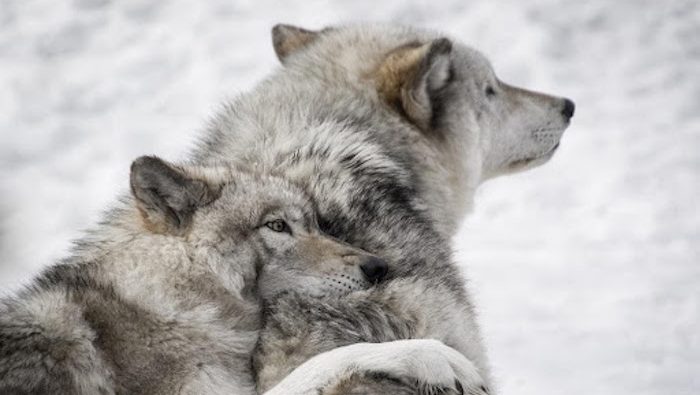Gray Wolves: Defenders of Wildlife
Known for forming tight social packs, Gray wolves are considered elegant predators. These majestic beings are a detonation of the wilderness and still can be found in the rural parts of the world. These wolves travel in small to very large packs, often led by alphas, the female and the male; Gray wolves typically hunt in their territories within 50 to 1,000 square miles.
Let’s explore more details about these magnificent beings.
Physical Description
Possessing large canine teeth, powerful jaws, and keen senses, a gray wolf will pursue its prey approximately 3 miles per hour, making them an extraordinary species. A typical northern male can weigh about 100 pounds and stand 30 inches tall. Their weight could range from 14 to 65 kg (31 to 143) depending on where they are born and bred. While males average to about 2 meters long, females are 20 percent smaller. Their large species could be found abundantly across Canada, Alaska, and northern Asia, whereas the smallest tends to be found in the Middle East, Arabia and India.
Their fur color differs from gray tone to brown, black, and even white, but their body’s lower parts are usually yellow-white. Around the arctic regions, gray wolves are generally light-colored.
Pack Behavior
A gray wolf pack commonly consists of 2 to over 20 wolves. Basically, formed of a family group, a gray wolf pack has a male and a female alpha; the rest are their offspring. Gray wolves are known to be socially strong. Their social bond greatly comes from the dominance hierarchy, which helps maintain order, command, and discipline. With the female alpha and the male alpha continuously switching roles to assert themselves equally on to each other, certain group activities are guided.
The care and defense of pups are predominated in the alpha females role while the alpha male provides food for the pack. Both sexes take equal parts in hunting down prey for food.
Pack’s Territory
Depending on prey abundance, a pack’s territory can range from 80 to 3,000 square km (31 to 1,200 sq mi) and is vigorously defended by the pack as a unit. Wolves communicate through visual cues (facial expression, body position, tail position), vocalizations, and scent marks. Howling helps the pack stay connected and strengthens social bonds between pack members. In addition to howling, marking territory with urine and feces lets nearby packs know not to interfere. Resident packs often kill intruders, but under certain circumstances, they are accepted.
Predators and Prey
Gray wolves hunt down large herbivores such as deer, moose, elk, sheep, caribou, and bison, mostly during nighttime during the warm weather. After eyeing its prey, the gray wolf will chase it and pull it to the ground. Gray wolves found in Alaska or Canada also hunt for salmon. After prey has been taken down, the pack consumes the whole animal. The pack will usually leave a few bones on the carcass before moving on to the next meal.
Biologists still disagree about the effect of wolves on the size of prey populations. Wolves can kill cattle and dogs when they get the chance, but many wolves that live near cattle rarely, if ever, kill them. The number of animals killed by wolves in North America is low but increasing as wolves expand their range. In 2018, wolves were thought to be responsible for the loss of hundreds of cattle and other livestock each year in the United States. To allay livestock owners’ concerns and mitigate potential backlash against wolves, several states have programs that compensate livestock owners for losses to their herds when there is evidence of a wolf attack on their animals.
During the 1990s, average annual wolf losses in Minnesota were 72 cattle, 33 sheep, and 648 turkey plus a few individuals of other livestock types. Livestock losses are highest in Eurasia. Wolves only survive by killing livestock and eating carrion and human waste in some areas. However, wolves generally avoid contact with humans. There have been no wolf attacks on humans in North America. Such attacks are unusual but have occurred in Eurasia and India and have occasionally resulted in death.
A Gray wolf has a life expectancy of thirteen years, but most die before that. Some lose their lives to parasite infestation or different infections such as rabies, Lyme disease, mange, or heartworm. Most deaths are caused due to declining prey populations resulting in starvation leading to death.
Breeding
Although Gray wolves can mate for a long time, January or February are usually the months in which they breed. Around five or six pups can be born within two months of breeding. The female alpha will usually give birth in a den around a hillside area. This den can be a hollow log, a small cave, an abandoned beavers lodge, or an inverted stump. Once the pups are born, they feed on their mothers’ milk for 1 to 2 months. After weaning off, they are given regurgitated forms of meat. The mother chews it to give it to her pups.
After three to four months, the pups are moved out of the den to an open area where they play and watch the alphas hunt. The summertime is for fun and play. As soon as fall arrives, the pack travels with its pups. By the time fall ends, the pups have grown into their adult size.
Conservation Status
After two or more years in the pack, many yearlings disperse in search for a mate, establish new territory and eventually start their own family. Those who stay with the pack can finally substitute a parent for becoming a breeding animal (alpha). Large packs appear to result from fewer young wolves leaving the pack and litters produced by more than one female. Wolves leaving their packs have been known to travel up to 886 km (550 miles).
Ubiquitous to human mythology, the Gray wolves have always been victims of a fair human share of misunderstandings. Early human societies seeking to survive admired the wolves. They tried to imitate its habits. Wolves are arguably more popular with the public today than at any other time in recorded history.
They were reintroduced from Canada to Yellowstone National Park in 1995. Some captive-bred Mexican gray wolves were also released in eastern Idaho in Arizona in 1998. At the start of the 21st century, an estimated 65,000 to 78,000 wolves inhabited North America. Canada had the largest population (although New Brunswick, Nova Scotia, and Prince Edward Island had no wolves), followed by Alaska and Minnesota.
Some western states, such as Michigan and Wisconsin, consist of smaller but recovering gray wolves. However, the protected status of wolves in Alaska and the lower 48 conditions continued to be debated and was removed from the US Endangered Species List in 2020. Populations in southern Europe are comparatively small but growing. The population found in Eurasia probably exceeds 150,000 and is stable or increasing in most countries, and most offer the wolves some degree of legal protection. Worldwide, wolves still occupy about two-thirds of their former range, but they remain viable. They have been listed as a species of most minor concern by the International Union for Conservation of Nature and Natural Resources since 1996.
Gray Wolves’ Intelligence
Gray wolves have a high intellect. Being able to experience a series of emotions, including joy, anger, empathy, grief, sympathy, and even jealousy, wolves are complex species. They remain highly dependent on each other and fiercely protect their pack. According to research, a famous female wolf from Yellowstone National Park co-parented with her younger brothers to look out for her litter of pups. After receiving an injury to his neck, the alpha male was cared for by his pack. They did not abandon the alpha male.
Wolves are known for giving their lives for another. If one wolf dies, the entire pack goes through great lengths of distress for the significant loss. Wolves can suffer from tremendous emotional, psychological and physical trauma, which might take several months to recover. Sudden killings can cause disruption in this network, which can affect the well-being of different wolves in it. Similarly, certain discrepancies in the breeding process or starvation of the pups further increase tensions in the pack.
Wrap Up
Gray wolves remain legendary because of their invigorating howl used mainly for communication purposes. They have been long used for fables and fictional stories; just as mystical as great predators, they can also be mysterious in every way.
Tweet





































